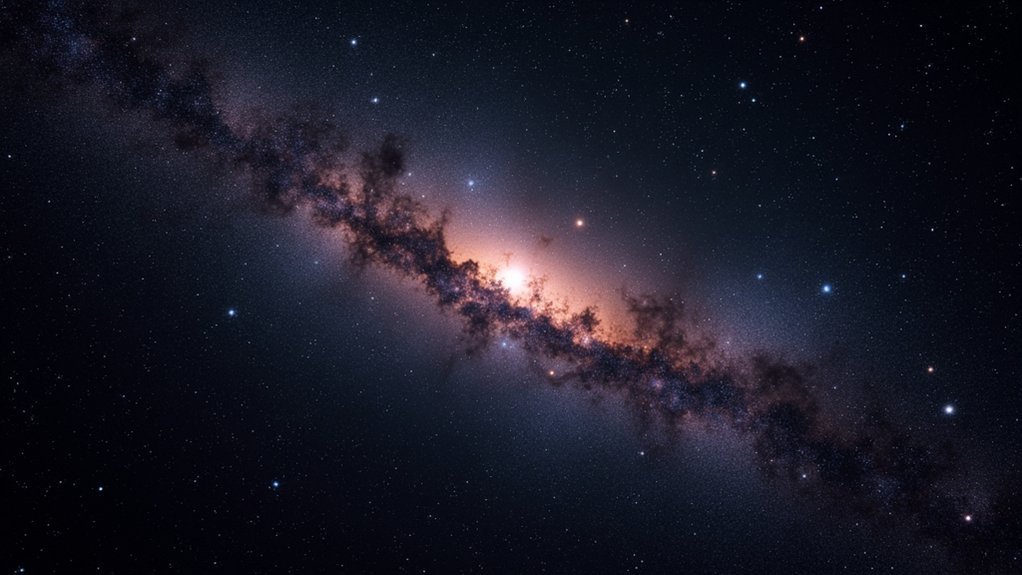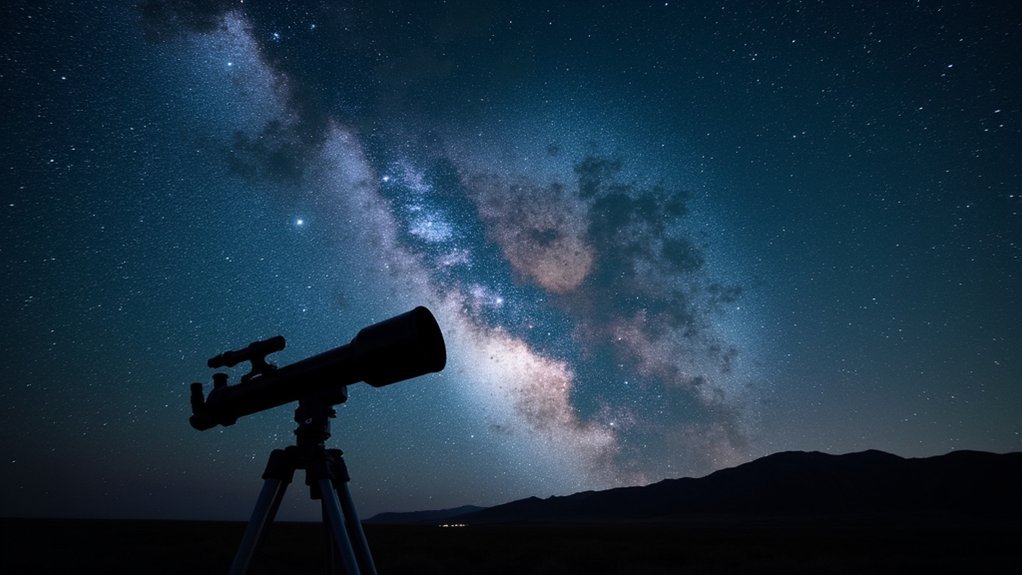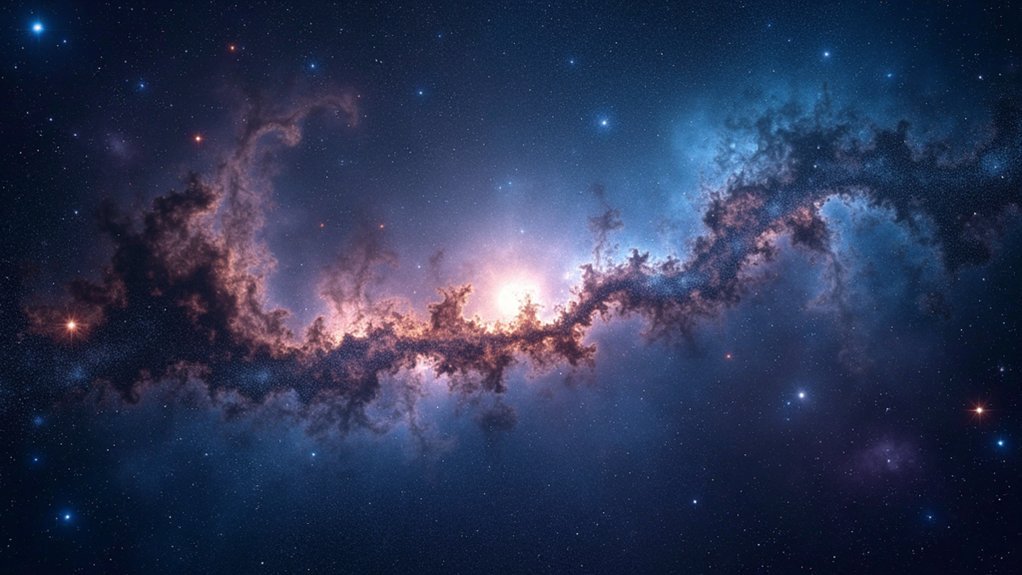Budget telescopes can reveal impressive star clusters like the Pleiades (M45) and Beehive Cluster (M44) with just 3-4 inches of aperture. You’ll spot globular clusters such as M13 in Hercules and open clusters like the Double Cluster in Perseus, with more detail visible in larger 6-8 inch apertures. Dark skies dramatically improve your views, while quality eyepieces enhance the experience. The right techniques transform even modest equipment into windows to celestial treasures.
Second-Level Headings for “What Deep Sky Clusters Can Budget Telescopes See?”

When exploring the night sky with budget telescopes, you’ll find several categories of deep sky clusters within easy reach. Your viewing journey naturally divides into distinct categories worth exploring systematically.
Start with globular clusters like M13 (Hercules) and M15, where your 4-inch or larger budget telescope will reveal thousands of stars packed tightly together.
Next, open clusters such as the Pleiades (M45) and the Beehive (M44) offer spectacular views with even modest equipment, showing individual stars beautifully scattered across your eyepiece.
Don’t miss the Double Cluster in Perseus, which provides dramatic contrast and detail.
While not a cluster, the Andromeda Galaxy (M31) should be on your list too, showing impressive structure through a 6-inch Dobsonian.
Remember that darker skies dramatically improve what your budget telescope can reveal.
Popular Open Clusters Visible With Entry-Level Telescopes
You’ll find different spectacular open clusters to observe throughout the year, with winter showcasing the brilliant Pleiades and Hyades, while summer brings the Wild Duck Cluster into prime viewing position.
Your telescope’s aperture directly affects how many individual stars you’ll resolve within each cluster—a 4-inch scope will reveal dozens of stars in the Pleiades, while a 6-inch will show considerably more.
Even from light-polluted locations, increasing your aperture from 3 to 6 inches can transform fuzzy patches into stunning stellar collections teeming with individual points of light.
Seasonal Viewing Highlights
Throughout the year, the night sky offers a rotating gallery of spectacular open clusters accessible even to those with modest equipment.
Spring skies showcase the dazzling Pleiades (M45) and Hyades clusters, both easily captured with a 6-inch Dobsonian telescope.
As seasons change, you’ll find the Beehive Cluster (M44) transforming from a fuzzy naked-eye patch into a collection of distinct stars through your budget telescope.
Fall brings the magnificent Wild Duck Cluster (M11) with its rich star field against the dark backdrop.
Winter rewards patient observers with the Double Cluster in Perseus (NGC 869 and NGC 884), a stunning pair of deep sky objects visible even in light-polluted areas.
Don’t miss the Orion Nebula (M42) during winter months—though not an open cluster, it’s a breathtaking seasonal viewing highlight for any budget telescope owner.
Aperture Size Matters
Three critical factors determine what you’ll see through your budget telescope, but aperture size tops the list.
When hunting deep-sky objects like open clusters, every millimeter of aperture enhances your viewing experience:
- Entry-level 70mm telescopes can reveal the stunning Pleiades (M45), Hyades, and the distinctive Coathanger Cluster even from suburban locations.
- 80mm apertures unveil the Beehive Cluster (M44) in Cancer, showing its honeycomb-like star pattern.
- 100mm (4-inch) telescopes dramatically improve views of all clusters and showcase the magnificent Double Cluster in Perseus.
- Dark skies amplify performance of any aperture size, allowing budget telescopes to reveal fainter stars and more intricate details within open clusters.
Remember: larger apertures gather more light, making the difference between seeing a smudge and resolving individual stars.
Remarkable Globular Clusters for Budget Stargazers

While many cosmic wonders require expensive equipment, globular clusters offer spectacular displays even through modest telescopes. You’ll be amazed at how these ancient stellar collections reveal their beauty through budget telescopes, making them perfect targets for amateur astronomers.
| Cluster | Location | Minimum Aperture |
|---|---|---|
| M13 | Hercules | 4 inches |
| M22 | Sagittarius | 4 inches |
| Omega Centauri | Centaurus | 6 inches |
M13, the famed Hercules Cluster, reveals thousands of tightly packed stars through a 4-inch scope. In Sagittarius, M22 shows its distinctive spherical shape with stunning star density. If you’re up for a challenge, point your telescope at M5 in Serpens to appreciate its intricate structure, or explore M15 in Pegasus with its highly concentrated core.
Stunning Messier Clusters Through Affordable Optics
You’ll discover impressive Messier clusters like M13, M45, and M44 through even modest 4-inch telescopes, revealing thousands of stars packed into breathtaking formations.
For ideal views, observe from darker locations on moonless nights when these clusters appear most vivid against the black sky.
Pair your budget telescope with wide-field eyepieces (20-25mm) to capture these extensive star fields and consider a light pollution filter if you’re viewing from suburban areas.
Messier Cluster Viewing Capabilities
What celestial treasures await budget-conscious stargazers?
With affordable instruments, you’ll discover that deep sky Messier clusters offer remarkable detail even through modest apertures.
Budget telescopes reveal surprising capabilities when turned toward these cosmic jewels.
- Star Clusters – A 130mm Dobsonian easily resolves M13 (Hercules Cluster) and M45 (Pleiades), showcasing their density and structure.
- Galaxies – M31 (Andromeda) appears as a faint smudge in smaller scopes, with spiral arms becoming visible in larger apertures.
- Nebulae – A 6-inch Dobsonian reveals M8 (Lagoon) and M20 (Trifid) with vibrant colors and intricate details.
- Urban Viewing – Even under light-polluted skies, bright Messier objects remain accessible, making deep sky clusters enjoyable regardless of your location.
Optimal Observing Conditions
Releasing the full potential of your budget telescope requires more than just knowing which clusters to target. The right observing conditions dramatically enhance what you’ll see through affordable optics.
Dark skies are your greatest ally. When you escape light pollution, your budget telescope can reveal stunning details in Messier clusters that remain hidden in urban settings. The contrast improvement is remarkable – M13 and M44 transform from fuzzy patches to spectacular stellar collections.
Spring nights during new moon phases offer ideal observing conditions, providing maximum darkness for cluster hunting.
You’ll want to verify your telescope’s mount is stable to eliminate vibrations, while quality eyepieces will help resolve individual stars in clusters like the Pleiades and M67. These practical adjustments maximize what your budget telescope can reveal.
Essential Equipment Tips
Three key upgrades can transform your budget telescope into a remarkable cluster-viewing instrument.
When hunting Messier clusters with affordable optics, prioritize these enhancements to maximize your experience.
- Quality eyepieces – Invest in a 25mm Plössl eyepiece for wider field views that capture the entirety of clusters like the Pleiades (M45).
- Aperture matters – Choose telescopes with at least 4 inches of aperture; 6-inch Dobsonians offer excellent value for viewing cluster details.
- Light pollution filters – These help improve contrast when observing from less-than-ideal locations.
- Finder scope upgrades – A quality finder makes locating clusters like the Hercules Cluster (M13) much easier.
Remember that even budget telescopes perform admirably under good observing conditions, so prioritize dark skies whenever possible for the most breathtaking views.
Best Seasonal Clusters for Sub-£500 Telescopes
While the night sky offers countless wonders, several spectacular deep sky clusters stand out as ideal targets for budget telescopes throughout the year.
The cosmos reveals its greatest treasures to even the most modest of astronomical instruments
In spring, you’ll get excellent views of the Hercules Cluster (M13) with a 130mm Dobsonian, while the Beehive Cluster (M44) in Cancer provides beginners with an accessible deep sky experience.
Winter showcases the breathtaking Pleiades (M45), which reveals its bright stars clearly through modest 4-inch refractors or 6-inch Dobsonians.
Don’t miss the Double Cluster in Perseus, particularly stunning through a 6-inch telescope that reveals intricate stellar details.
When equipped with a quality 130mm reflector, you can explore the Orion Nebula (M42) in winter and early spring, observing its vibrant stellar nursery when it’s ideally positioned high in the sky.
Observing Techniques to Maximize Cluster Views on a Budget

Getting the most from your budget telescope doesn’t require expensive equipment upgrades, but rather mastering a few essential observing techniques.
Even a good telescope with a 4-inch aperture can reveal stunning deep sky clusters when you know how to optimize your viewing conditions.
- Choose your timing wisely – Observe during new moon phases to minimize natural light interference.
- Combat light pollution – Seek darker locations whenever possible, as urban glow can obscure fainter clusters.
- Use quality observing guides – Employ apps like Pocket Sky Atlas to easily locate bright targets like M13 and M45.
- Practice dark adaptation – Allow your eyes 20-30 minutes to adjust to darkness while using your optical finder scope to navigate efficiently.
Equipment Recommendations for Deep Sky Cluster Hunting
Although advanced telescopes offer impressive views, budget astronomers can still enjoy spectacular deep sky clusters with the right equipment choices. 6″ and 8″ Dobsonians provide excellent value, revealing treasures like M13 and M44 with surprising detail.
| Equipment | Aperture | Best Clusters |
|---|---|---|
| Dobsonian | 6″-8″ | Hercules (M13), Beehive (M44) |
| Refractor | 4″ | Pleiades (M45), Double Cluster |
| Reflector | 130mm+ | Most Messier clusters |
Don’t overlook accessories—an 8×50 optical finder scope dramatically improves your ability to locate deep sky clusters. Since dark skies are essential for cluster hunting, choose portable budget telescopes that you can easily transport to locations away from light pollution.
Urban vs. Dark Sky Cluster Observations With Budget Equipment

Despite urban light pollution limitations, you can still enjoy impressive deep sky clusters with budget telescopes. Your budget telescope experiences will vary dramatically between urban and dark sky locations, with the latter revealing notably more detail and fainter objects.
Don’t let city lights dim your astronomy dreams—budget telescopes can still reveal celestial wonders.
For urban astronomy enthusiasts using budget telescopes:
- Bright showpieces like the Pleiades (M45) and Orion Nebula (M42) remain visible even with light pollution.
- Large open clusters such as the Beehive Cluster (M44) show up well in both settings, though with better contrast in dark skies.
- Urban locations typically limit your deep sky objects to a few dozen visible clusters.
- Proper collimation and larger apertures can help overcome urban limitations, revealing details in clusters like M11.
Moving to dark skies transforms your budget telescope, increasing visible objects from dozens to potentially a thousand.
Photographing Star Clusters With Affordable Telescope Setups
With the right techniques, you can capture stunning images of star clusters using even the most affordable telescope setups. A smartphone adapter paired with a budget telescope like the Celestron StarSense Explorer lets you photograph directly through the eyepiece, making astrophotography accessible to beginners.
For more detail, try long exposure photography by stacking multiple images. This reduces noise and enhances faint details in clusters like the Beehive (M44), which photographs well through modest 100mm refractors under dark skies.
Don’t let an alt-azimuth mount limit you—manual tracking works effectively for maintaining focus during longer exposures.
A 6″ Dobsonian can reveal impressive details of the Pleiades (M45) and Hercules Cluster (M13) when paired with appropriate eyepieces and basic photography equipment.
Frequently Asked Questions
What Can You See With Budget Telescope?
You’ll see bright objects like the Pleiades, Hercules Cluster, and Andromeda Galaxy with budget telescopes. You can also observe the Orion Nebula’s glowing gas clouds and spot distinctive clusters like NGC 457.
What Planets Can You See With a Cheap Telescope?
With a cheap telescope, you’ll easily see Jupiter’s bands and moons, Saturn’s magnificent rings, Mars’ polar caps, and Venus’ phases. You can even spot Uranus and Neptune as tiny bluish dots.
What Is the Best Budget Telescope to See Planets?
For the best budget planetary views, you’ll want a 6-inch Dobsonian like the Orion SkyQuest XT6. It offers excellent light-gathering ability, stable mounting, and sufficient aperture to reveal Saturn’s rings and Jupiter’s cloud bands.
Can You See the Moon With a Cheap Telescope?
Yes, you’ll see the Moon beautifully with a cheap telescope. Even basic 70mm refractors or 76mm Newtonians clearly reveal craters, maria, and surface details at 100x magnification, even from light-polluted areas.
In Summary
You’ll find that even budget telescopes open up a fascinating world of star clusters. Whether you’re enjoying the Pleiades, spotting M13, or hunting seasonal targets, affordable equipment can deliver stunning views. Remember to use proper techniques, choose dark locations when possible, and consider simple photography options. With patience and practice, you’ll soon be identifying dozens of beautiful clusters in our night sky.





Leave a Reply